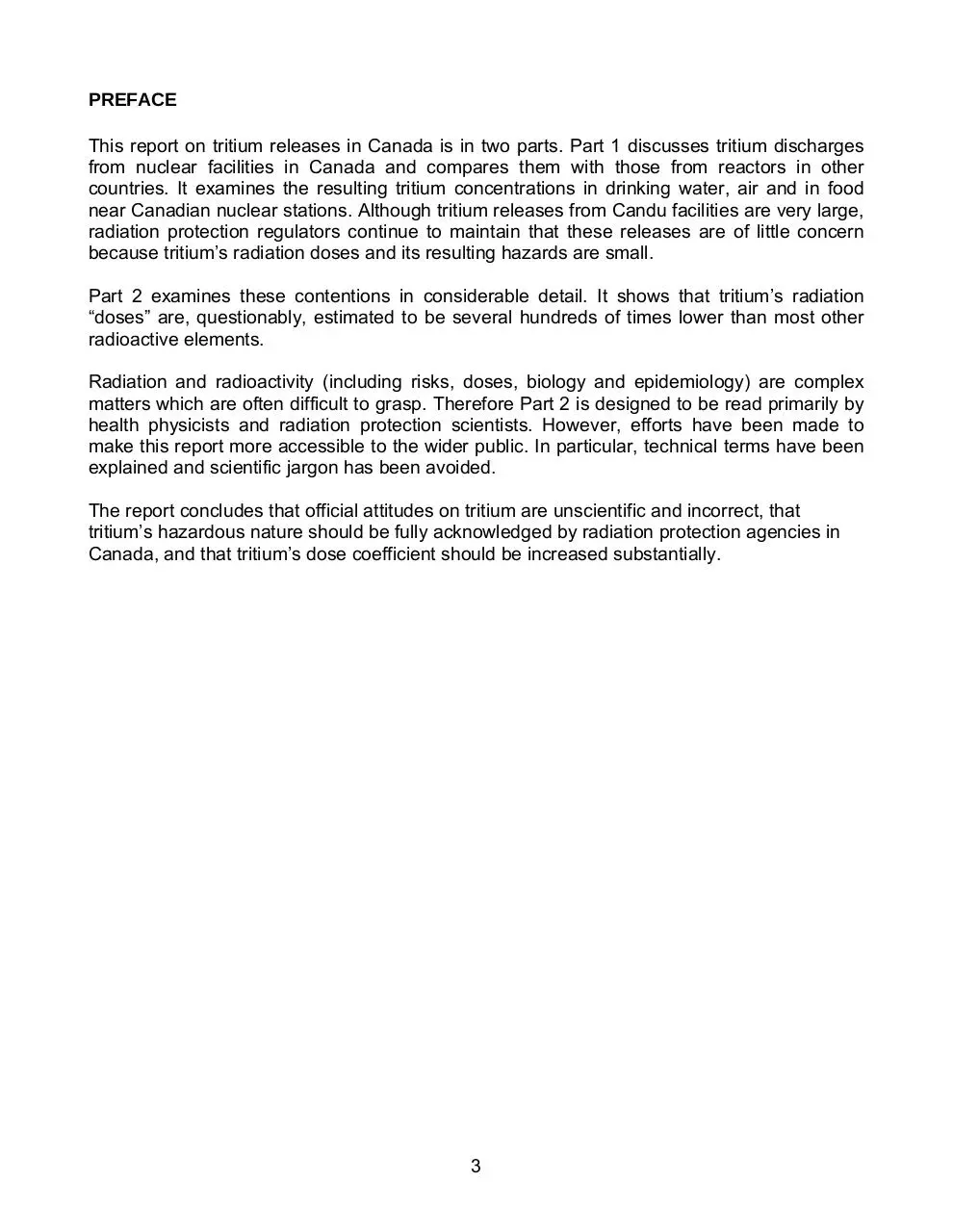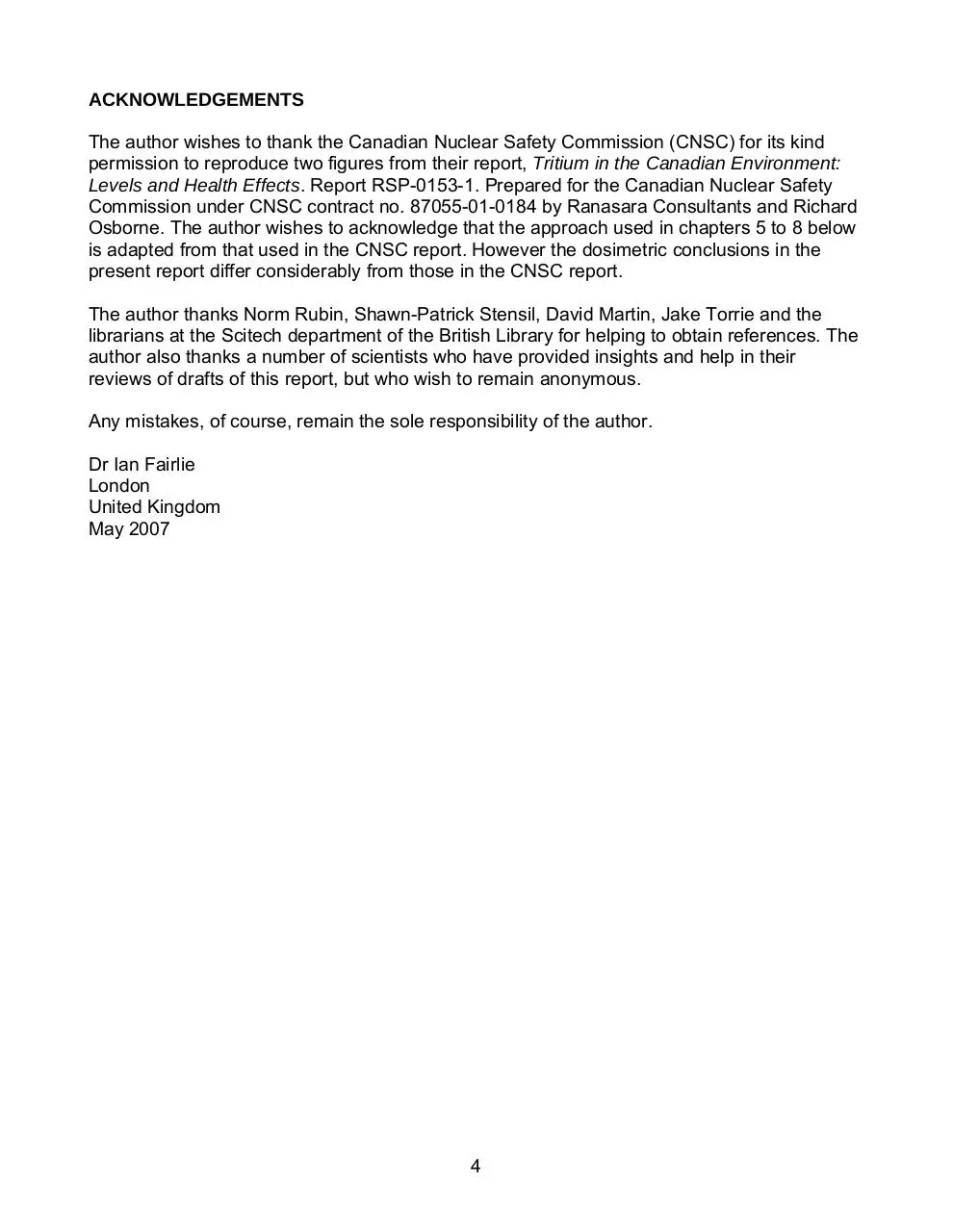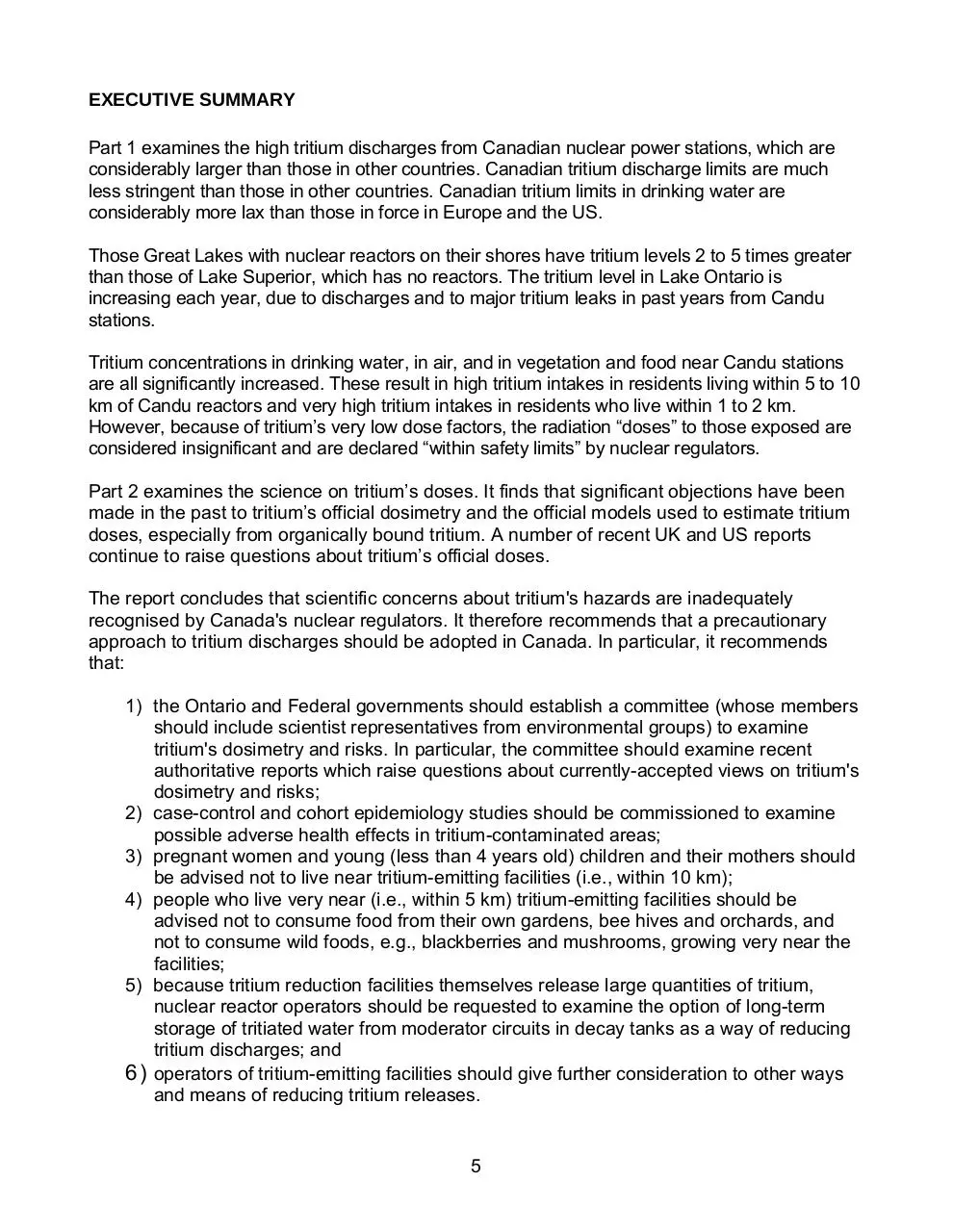tritium report canadian facilities (PDF)
File information
Title: Microsoft Word - Tritiumstudyfinal-11-06-07.doc
Author: sp
This PDF 1.4 document has been generated by PScript5.dll Version 5.2.2 / Acrobat Distiller 6.0.1 (Windows), and has been sent on pdf-archive.com on 07/02/2016 at 20:04, from IP address 74.69.x.x.
The current document download page has been viewed 796 times.
File size: 449.09 KB (92 pages).
Privacy: public file





File preview
Tritium Hazard Report:
Pollution and Radiation Risk from
Canadian Nuclear Facilities
By Dr. Ian Fairlie
June 2007
1
2
PREFACE
This report on tritium releases in Canada is in two parts. Part 1 discusses tritium discharges
from nuclear facilities in Canada and compares them with those from reactors in other
countries. It examines the resulting tritium concentrations in drinking water, air and in food
near Canadian nuclear stations. Although tritium releases from Candu facilities are very large,
radiation protection regulators continue to maintain that these releases are of little concern
because tritium’s radiation doses and its resulting hazards are small.
Part 2 examines these contentions in considerable detail. It shows that tritium’s radiation
“doses” are, questionably, estimated to be several hundreds of times lower than most other
radioactive elements.
Radiation and radioactivity (including risks, doses, biology and epidemiology) are complex
matters which are often difficult to grasp. Therefore Part 2 is designed to be read primarily by
health physicists and radiation protection scientists. However, efforts have been made to
make this report more accessible to the wider public. In particular, technical terms have been
explained and scientific jargon has been avoided.
The report concludes that official attitudes on tritium are unscientific and incorrect, that
tritium’s hazardous nature should be fully acknowledged by radiation protection agencies in
Canada, and that tritium’s dose coefficient should be increased substantially.
3
ACKNOWLEDGEMENTS
The author wishes to thank the Canadian Nuclear Safety Commission (CNSC) for its kind
permission to reproduce two figures from their report, Tritium in the Canadian Environment:
Levels and Health Effects. Report RSP-0153-1. Prepared for the Canadian Nuclear Safety
Commission under CNSC contract no. 87055-01-0184 by Ranasara Consultants and Richard
Osborne. The author wishes to acknowledge that the approach used in chapters 5 to 8 below
is adapted from that used in the CNSC report. However the dosimetric conclusions in the
present report differ considerably from those in the CNSC report.
The author thanks Norm Rubin, Shawn-Patrick Stensil, David Martin, Jake Torrie and the
librarians at the Scitech department of the British Library for helping to obtain references. The
author also thanks a number of scientists who have provided insights and help in their
reviews of drafts of this report, but who wish to remain anonymous.
Any mistakes, of course, remain the sole responsibility of the author.
Dr Ian Fairlie
London
United Kingdom
May 2007
4
EXECUTIVE SUMMARY
Part 1 examines the high tritium discharges from Canadian nuclear power stations, which are
considerably larger than those in other countries. Canadian tritium discharge limits are much
less stringent than those in other countries. Canadian tritium limits in drinking water are
considerably more lax than those in force in Europe and the US.
Those Great Lakes with nuclear reactors on their shores have tritium levels 2 to 5 times greater
than those of Lake Superior, which has no reactors. The tritium level in Lake Ontario is
increasing each year, due to discharges and to major tritium leaks in past years from Candu
stations.
Tritium concentrations in drinking water, in air, and in vegetation and food near Candu stations
are all significantly increased. These result in high tritium intakes in residents living within 5 to 10
km of Candu reactors and very high tritium intakes in residents who live within 1 to 2 km.
However, because of tritium’s very low dose factors, the radiation “doses” to those exposed are
considered insignificant and are declared “within safety limits” by nuclear regulators.
Part 2 examines the science on tritium’s doses. It finds that significant objections have been
made in the past to tritium’s official dosimetry and the official models used to estimate tritium
doses, especially from organically bound tritium. A number of recent UK and US reports
continue to raise questions about tritium’s official doses.
The report concludes that scientific concerns about tritium's hazards are inadequately
recognised by Canada's nuclear regulators. It therefore recommends that a precautionary
approach to tritium discharges should be adopted in Canada. In particular, it recommends
that:
1) the Ontario and Federal governments should establish a committee (whose members
should include scientist representatives from environmental groups) to examine
tritium's dosimetry and risks. In particular, the committee should examine recent
authoritative reports which raise questions about currently-accepted views on tritium's
dosimetry and risks;
2) case-control and cohort epidemiology studies should be commissioned to examine
possible adverse health effects in tritium-contaminated areas;
3) pregnant women and young (less than 4 years old) children and their mothers should
be advised not to live near tritium-emitting facilities (i.e., within 10 km);
4) people who live very near (i.e., within 5 km) tritium-emitting facilities should be
advised not to consume food from their own gardens, bee hives and orchards, and
not to consume wild foods, e.g., blackberries and mushrooms, growing very near the
facilities;
5) because tritium reduction facilities themselves release large quantities of tritium,
nuclear reactor operators should be requested to examine the option of long-term
storage of tritiated water from moderator circuits in decay tanks as a way of reducing
tritium discharges; and
6) operators of tritium-emitting facilities should give further consideration to other ways
and means of reducing tritium releases.
5
PART 1: TRITIUM RELEASES IN CANADA
Chapter 1 INTRODUCTION ..................................................................................................6
What is tritium? ..................................................................................................................7
Organically bound tritium (OBT) ........................................................................................8
Chapter 2 TRITIUM RELEASES IN CANADA.......................................................................9
Tritium Releases Compared ............................................................................................10
Why do heavy water reactors discharge large amounts of tritium? .................................10
Tritiated Water Vapour Emissions to Air ..........................................................................11
Tritium - Liquid Water Discharges....................................................................................11
History of Tritium Inventories of Candu Reactor Circuits .................................................12
Problems with High Tritium Concentrations.....................................................................13
Can Tritium Releases be Reduced? ................................................................................15
Chapter 3 TRITIUM DISCHARGE LIMITS ..........................................................................16
Chapter 4 TRITIUM LIMIT IN DRINKING WATER ..............................................................18
Only one year’s exposure assumed.................................................................................18
Ontario Government’s ACES Report (1994): A Sorry Episode ........................................19
Chapter 5 TRITIUM CONCENTRATIONS IN THE GREAT LAKES ....................................20
History of Tritium Leaks into the Great Lakes..................................................................21
Chapter 6 TRITIUM-IN-AIR CONCENTRATIONS NEAR NUCLEAR STATIONS...............22
The real background level of airborne tritiated water vapour ...........................................24
Historical trends ...............................................................................................................24
Chapter 8 HOW MUCH TRITIUM DO PEOPLE TAKE IN? .................................................28
Are these levels hazardous? ...........................................................................................32
Chapter 9. ARE HIGH TRITIUM LEVELS HAZARDOUS TO HEALTH? ...............................33
Recent Reports................................................................................................................34
Would increasing tritium’s dose factors make a difference? ............................................34
Occupational doses .........................................................................................................35
Epidemiology ...................................................................................................................35
Chapter 10 CONCLUSION and RECOMMENDATIONS.....................................................36
REFERENCES in Part 1 .....................................................................................................37
Annex 1. Carbon-14................................................................................................................42
Annex 2. Wind Frequencies for Darlington and Pickering.......................................................43
Annex 3. Tritium Releases from SRB Technologies, Pembroke Ontario.
6
Chapter 1
Introduction
What is tritium?
Tritium is the radioactive isotope of hydrogen, the smallest and lightest element. It has a
radiological half-life of 12.3 years and decays to the stable isotope helium (3He), emitting a beta
particle (and a neutrino). The beta particle has a maximum energy of 18.6 kilo electron volts
(keV) (average energy of 5.7 keV) with a short range—a few centimetres in air, 0.9
micrometers (µm) in water, and about 0.6µm in tissue. This means that tritium is not
dangerous externally, but it is an internal radiation hazard when inhaled, or ingested via food
or water, or absorbed through the skin. Tritium is the most commonly encountered and
important beta-emitting radionuclide.
Tritium has always kindled much interest among scientists and has been widely studied in the
past: see Appendix 1 to Part 2 of this report, NCRP (1979), NEA (1980), ACRP (1991), and
CCNR, http://www.ccnr.org/tritium_1.html. More recent studies on tritium can be found in
various reports and websites. For example, see the following:
• US Environmental Protection Agency website on tritium,
http://www.epa.gov/radiation/radionuclides/tritium.htm (accessed February 26, 2007)
• The report by Richard Osborne (2002), Tritium in the Canadian Environment: Levels and
Health Effects. Report RSP-0153-1. Prepared for the Canadian Nuclear Safety
Commission under CNSC contract no. 87055-01-0184 by Ranasara Consultants and
Richard Osborne
• A tritium report by the US Agency for Toxic Substances and Disease Registry
http://www.atsdr.cdc.gov/hac/PHA/livermore4/lms_toc.html
• A forthcoming report on tritium by the UK Government’s Advisory Group on Ionising
Radiation http://www.hpa.org.uk/radiation/advisory_groups/agir/index.htm
Tritium is discharged in two main forms. In its elemental form (HT), it is an invisible, odourless
gas chemically identical to hydrogen gas. In its water form (i.e., tritiated water, or HTO), it is
practically indistinguishable from ordinary water. In fact, it is useful to think of tritium as
radioactive water because this is by far its most common form. Tritium releases from Canadian
nuclear plants are mostly tritiated water; the tritium recovery facility at Darlington emits tritium
gas (HT).
Both forms of tritium are very radioactive (in technical terms, they have high specific activities).
One gram of HT contains about 360 terabecquerels1 (TBq) of radioactivity, and one gram of
HTO contains about 55 TBq2 of radioactivity. Both forms of tritium are very pervasive; HT
permeates most materials, rubber and many grades of steel with relative ease, and HTO—being
chemically identical and physically similar to ordinary water—very rapidly mixes throughout the
atmosphere, hydrosphere, lithosphere and biosphere, in short, everywhere. HT is converted to
HTO in dry indoor conditions at the rate of about 1% per hour—faster in humid conditions. It is
readily converted to HTO by bacteria in soil.
Tritium has a number of unusual properties apart from its rapid distribution throughout the
environment. One is its property of exchanging rapidly with other H atoms in the environment—
1
2
9,800 curies (Ci) in old units
1,500 Ci in old units
7
including in humans. Another is its propensity to form strong bonds with carbon to form
organically bound tritium (OBT) during metabolic reactions and in cell reproduction (see box
below).
Organically bound tritium (OBT)
OBT is tritium which has become chemically attached to carbon atoms3 in organic molecules.
Organic binding is tritium’s most significant property, but, unfortunately, official dose models
for OBT underestimate its hazards.
Humans can accumulate OBT in two ways. The first is by consuming OBT in food, e.g.,
vegetables, wheat, honey, milk, that has been grown and harvested in areas near Candu
reactors contaminated by tritiated water vapour. The second is by drinking/eating, breathing,
and absorbing tritiated water that then is then both metabolised into organic molecules
needed by the body, and incorporated into new cells.
OBT is more problematic than HTO for two reasons. First because OBT’s residence time (i.e.,
half-life) in humans is much longer (20 to 50 times) than HTO’s residence time (see Part 2 of
this report). And second because OBT must by definition be located near organic molecules
(such as DNA) more often than HTO. As stated by Taylor et al (1990) ”... the concentration of
OBT in tissues of interest, are greater by up to an order of magnitude after ingestion of OBT
than after HTO ingestion...”. This means that radiation exposures from OBT are much larger
than that from HTO.
Like most radionuclides, tritium is a carcinogen, mutagen and teratogen. Many scientists have
expressed concerns about tritium’s radiotoxicity (see Appendix 1 of Part 2). However, some
radiation authorities continue to assert, rather misleadingly, that tritium is a “weak” radionuclide
because the energy of its decay particle is very low. However, paradoxically, in radiation biology
the weaker a particle the more effective it becomes. Unfortunately this remains unrecognised in
official circles and tritium’s official dose factor (i.e., the dose given by the disintegration of one
atom of tritium) is currently very small. Indeed, it is the lowest among common radionuclides by
some margin. There are many questions about tritium’s official radiation doses: these are
considered in detail in Part 2.
Tritium is naturally formed in the upper atmosphere by cosmic rays. The quantity of tritium thus
produced each year is ~ 7.4 x 104 TBq (Luykx and Fraser, 1986). In Western developed
countries in the early 1980s, the annual amounts released by civil nuclear power and
reprocessing facilities (Masschelein and Genot, 1983; NEA/OECD, 1980) were about the same
or higher. These will have increased since then to exceed tritium’s natural production rate.
In addition, much larger amounts of tritium are released from military activities. Between
1954 and 1962, atmospheric weapons testing released extremely large amounts of tritium—
1.6 x 108 TBq, almost all in the northern hemisphere (UNSCEAR, 1988). By 2007, this will
have decayed about 16-fold. In addition, at the height of the cold war in the 1970s and 1980s,
annual tritium discharges from nuclear weapons manufacturing amounted to 2.8 x 106 TBq
(Jaworowski, 1982). This included the US nuclear weapons plants at Savannah River and
3
Another form of OBT is tritium that attaches to O, P, N and S atoms. These bonds are weaker than C-H bonds
and their average half-life is shorter (about 30 days) than that of tritium bound to C atoms (1 to 2 years). This is
exchangeable OBT and is discussed in Part 2.
8
Hanford, which annually emitted on average 1.1 x 105 TBq (NCRP, 1979) in the 1950s to the
1980s.
Chapter 2
Tritium Releases In Canada
Most tritium releases in Canada are from Candu nuclear power generating stations, as shown
in the following tables. In addition, substantial tritium releases occur from the SRB
Technologies facility in Pembroke, Ontario, which are reported in Annex 3 below. This facility
manufactures tritium-containing emergency lighting equipment.
Tables 2.1 to 2.4 reproduce recent releases of tritium from Candu nuclear stations.
Table 2.1 Recent emissions of tritium oxide (HTO) to air (TBq/a)
2001
2002
2003
2004
Bruce A + B
650
580
560
864
Pickering A + B
580
510
480
620
Darlington
240
190
170
280
Gentilly-2
190
180
150
260*
Point Lepreau
140
130
100
100*
TOTALS
1800
1590
1460
2120
2005
731
500
130
180*
180*
1720
*estimated reading from graphs
Table 2.2 Recent discharges of tritium oxide (HTO) to water (TBq/a)
2001
2002
2003
2004
2005
Bruce A + B
163
414
860
585
426
Pickering A + B
280
427
258
290
260
Darlington
94
69
100
160
220
Gentilly-2
450
500
350
120*
360*
Point Lepreau
150
140
81
100*
220*
TOTALS
1187
1410
1649
1250
1490
*estimated reading from graphs
Table 2.3 Air releases of elemental tritium (HT) (TBq/a)
2001
2002
2003
Darlington
108
56
66
2004
750
Table 2.4 Canada—Total tritium released (TBq/a, rounded to 3 figs)
2001
2002
2003
2004
HT
110
56
66
750
HTO to water
1190
1410
1650
1250
HTO to air
1800
1590
1460
2120
TOTALS
3100
3100
3200
4120
2005
790
2005
790
1490
1720
4000
Sources: NPRI, 2004, 2003, 2002.
OPG and Bruce Power annual environmental reports—OPG (2006) and Bruce Power (2006).
9
Download tritium-report-canadian-facilities
___tritium-report-canadian-facilities.pdf (PDF, 449.09 KB)
Download PDF
Share this file on social networks
Link to this page
Permanent link
Use the permanent link to the download page to share your document on Facebook, Twitter, LinkedIn, or directly with a contact by e-Mail, Messenger, Whatsapp, Line..
Short link
Use the short link to share your document on Twitter or by text message (SMS)
HTML Code
Copy the following HTML code to share your document on a Website or Blog
QR Code to this page

This file has been shared publicly by a user of PDF Archive.
Document ID: 0000338307.